Circumbinary planets are those that orbit two stars, a small but growing category of worlds — we’ve detected some 14 thus far, thanks to Kepler’s good work, and that of the Transiting Exoplanet Survey Satellite (TESS). The latest entry, TIC 172900988, illustrates the particular challenge such planets represent. Transit photometry is a standard method for finding planets, detecting the now familiar drop in starlight as the planet moves between us and the surface of the host star. Kepler found thousands of exoplanets this way. But when two stars are involved, things get complicated.

Image: The newly discovered planet, TIC 172900988b, is roughly the radius of Jupiter, and several times more massive, but it orbits its two stars in less than one year. This world is hot and unlike anything in our Solar System. Credit: PSI/Pamela L. Gay.
Three transits are required to determine the orbital path of a planet. For us to make a detection, a circumbinary planet will have to transit both stars, but the timing of the transits can vary. The planet may transit the first star, then the second, before returning to transit the first. Nader Haghighipour (Planetary Science Institute) points out that the orbital period of a circumbinary planet will always be much longer than the orbital period of the binary star, and that means detecting three transits will be problematic for a telescope like TESS, which observes each portion of sky for only 27 days.
The paper on the discovery of TIC 172900988b lays out these problems:
Finding transiting planets orbiting around binary stars is much more difficult than around single stars. The transits are shallower (due to the constant ‘third-light’ dilution from the binary companion), noisier (due to starspots and stellar activity from two stars), and can be blended with the stellar eclipses. This difficulty is greatly compounded when the observations cover a single conjunction and, even if multiple transits are detected as in the system presented here, they are neither periodic, nor have the same depth and duration… The transit times and shapes depend on the orientation and motion of the binary stars and of the CBP [circumbinary planet] at the observed times. The complexity of such transits is both a curse and a blessing…
A blessing, the authors argue, because such a detection yields information “richer than what can be obtained from a single transit of a single-star planet,” offering better estimation of the planet’s orbital period.

Image: A newly discovered planet was observed in the system TIC 172900988. In TESS data, it passed in front of the primary star (right) and 5 days later (shown) passed in front of the second star (left). These stars are just over 30% larger than the Sun, and differ very little in size. Credit: PSI/Pamela L. Gay.
Haghighipour is part of a team of astronomers with circumbinary planet experience; he also contributed to a 2020 paper in The Astronomical Journal that produced a technique for discovering circumbinary planets using only two transits, one across each star during the same conjunction. It was this method, ideally suited for TESS, that led the same team to make the just announced discovery of TIC 172900988b. This is the first TESS circumbinary planet to be found using these methods.
TIC 172900988b takes 200 days to complete a full orbit of the binary system. The planet is a gas giant of Jupiter size, the most massive transiting circumbinary planet found thus far. The team, led by Veselin B. Kostov (SETI Institute), observed it transit the primary star, followed five days later by a transit of the secondary, as the binary eclipsed itself over a 20-day orbit.
The Kepler mission discovered its circumbinary worlds by finding pairs of transits during a single conjunction, making it clear that the phenomenon is common. In fact, Jean Schneider and Michel Chevreton (both at the Paris Observatory) analyzed this likely observational signal as far back as 1990 in a paper for Astronomy and Astrophysics. Now TESS has a circumbinary discovery of its own, despite its much shorter dwell time on the stars in its field. Adds Kostov:
“The occurrence of multiple closely-spaced transits during one orbit is a unique observation signature of transiting circumbinary planets. This is a geometrical phenomenon that provides a new planet detection method. The discovery of TIC 172900988b is the first demonstration that the method works.”

Image: This is Figure 5 from the paper. Caption: The photometric data shown in Figure 4 phase-folded on a linear period of P = 19.65802 days. The left panel shows the primary eclipse and the right panel shows the secondary eclipse. The different data sets are vertically offset in the lower panels for clarity. The phase change of the secondary eclipse relative to the primary—indicative of the apsidal motion of the binary—is clearly seen in the right panels. Credit: Kostov et al.
We learn in the paper’s analysis of the detection that no further data from TESS will become available on this planet, making future study the province of other instruments. From the paper:
We note that TESS will observe the target again in Sectors 44 through 47 (2021 October to 2022 January). Unfortunately, it will miss the predicted transits for the corresponding conjunctions by several weeks. Thus follow-up observations from other instruments are key for strongly constraining the orbit and mass of the CBP [circumbinary planet]. In particular, observing the predicted 2022 February-March conjunction of the CBP is critical for solving the currently-ambiguous orbit of the planet. As a relatively bright target (V = 10.141 mag), the system is accessible for high resolution spectroscopy, e.g. Rossiter-McLaughlin effect, transit spectroscopy. TIC 172900988 demonstrates the discovery potential of TESS for circumbinary planets with orbital periods greatly exceeding the duration of the observing window.
The paper is Kostov et al., “TIC 172900988: A Transiting Circumbinary Planet Detected in One Sector of TESS Data,” The Astronomical Journal 162, No. 6 (10 November 2021), 234 (abstract / preprint).



With both stars orbiting each other and the planet transiting both with what must be varying periods between the transit pairs – that is really some untangling to be done. I assume that the stars also transit each other very obviously, so that their orbital period can be deduced.
Can planets orbiting double stars be in any sort of habitable zone, even relatively transiently? I would imagine that during the occultation of one star by the other, the planet must get very cold unless the occultation is very brief, like our Moon occulting the sun. But with 2 stars, I would infer that the orbital semi-major axis must be large and the orbital period long, precluding any habitable zone around 2 stars. Is this correct or not?
The article contains some of what you are asking about. The stars are in a tight orbit and the planet relatively far away, as it must be. Considering the stellar masses and the 200 day planetary orbit, the planet must be in a tight orbit and that’s why it’s hot. Further out I think the HZ would be pretty stable, eclipses or not, since the binary separation will be much smaller than than the orbit radius. That is, the isolation would vary little since the stars vary little in their distance to a planet in the HZ.
Thank you. So what I think you are saying in more concrete terms is that if our sun was 2 smaller stars orbiting at say 0.1 AU, with a combined output that is the same as the sun, the HZ would be stable for our Earth. The eclipsing of one star by the other would not have that much effect, perhaps some temporary cooling partially/mostly balanced by the occulting star getting closer to the Earth.
This Wikipedia article expands on this a little, but without much detail.
More details in this paper: Climate variations on Earth-like circumbinary planets
That is a terribly brief WP article, but at least it gives minimum values for those P orbits. But with a tight binary, although potentially favorable to habitable planets, the interactions between them during system formation and for a long time afterward can make for a high radiation environment. Too much interaction will also cause the stellar orbital radii to contract. A theoretically stable HZ might not be so in practice.
In my maths responding to Mr Tolley below, I found the stars are likely separated by 14 of their diameters, Mr S. I don’t think this sytem would have the activities you mention, as this system while tight is very much not a contact or near-contact binary. The situation seems ‘hopeful’.
This would be an interesting case for a putative habitable zone planet. But I would suspect that when one considers the concerns with synchronous rotation of a planet in a single star system vs. a non synchronous rotation such as ours, there could be some benefit in stellar transit events akin to night and day. Likely with as much offset as planets in this system would have ( e.g.,” hot” at 200 day rotation period), rotational angular momentum would not have dissipated in the HZ.
During a period of examining stability of planets in binary systems, I did some analysis of close binaries measured in days,
but I had to farther afield than the list of “nearest stars” to get a representative. Because most of the local binaries range from decades to centuries in their periods. The particular sample binary I selected was in Alpha Geminorum (Castor); but since it involves six stars total ( for now…)I hesitate to settle on which.
The close binary red dwarfs did not appear to effect near term HZ stability. The Castor complex of binaries could be a rich environment for planets, but not necessarily aligned well for detections, especially for transits. And if red dwarfs could sustain life, and they are set up in binaries, then this might be the place to be.
Maybe even two red dwarfs swirling over head are better than one?
I didn’t read through the climate variations paper you cited, Mr Tolley, as I think a little maths can go a long way here.
First, these stars are each 30% larger than our sun, so I guess similarly more massive (I’ve noticed how near-proportional mass and radius are for lower mass main sequence stars).
At a 20 day period, Kepler’s third law gives a mean separation of 0.198 A.U. I used the version where M is normalised to the Solar mass, P to the Earth year, and A to 1 A.U., thus MP² = A³ in those units. Taking M = 2 × 1.3, and P = 20 days ÷ 365.25 days, gives A = 0.198 A.U.
It’s worth noting first the ratio of near to far distance of each star from a planet in the habitable zone before working on the eclipse duration. But where is the habitable zone?
If a main sequence star’s luminosity scales as M^3.5, each star radiates at 1.3^3.5 = 2.50 Solar luminosities. We have twice that, so 5 Solar luminosities. That puts the Earth-equivalent insolation at the square root of that in A.U.: ?5 = 2.24 A.U. (period 760 days).
So, the further star appears 2.24 ÷ ( 2.24 + (0.198 ÷ 2) ) = 95.8% of its mean size, while the nearer star appears 2.24 ÷ ( 2.24 – (0.198 ÷ 2) ) = 104.6% of its mean size. One appears about 10% larger than the other.
If we square those sizes and add them, we’ll get the factor of variation in insolation due the stars’ orbital motions on the planet. That’s: ( 0.958² + 1.046² ) ÷ 2 = 1.006. So, there’s a 0.6% variation in insolation as the stars oscillate from maximum elongation from each other to conjunction. Compare to ±3.4% for Earth just from its orbital eccentricity.
Eclipse duration is close to the duration of one star to move it’s own width* (that is, we can neglect that the more distant one appears slightly smaller, and vice versa, because we see that’s only about 10%).
As it happens, the Solar diameter is pretty much 0.010 A.U., so each star’s diameter is 0.013 A.U. To move that distance on the circumference of its orbit takes 20 days × 0.013 ÷ ( 2 × 3.14 × ( 0.198 ÷ 2 ) ) = 10.0 hours. In that time, the planet moves 0.2° in its orbit, so we can ignore that in estmating the eclipse duration.
So, the 10 hour eclipse every 20 days reduces mean annual insolation by half of 2.1% (because one star still shines unobscured). That will be a colder day, but it’s not night, not even twilight.
Meanwhile, at maximum elongation, the stars are separated by about 14 times their diameters, or about 4.4°, so daylight lasts a little longer, but I think the daily averaged insolation remains the same.
I wonder if I got all that right?
Anyway, I think this establishes that some sort of habitable zone can exist for P-type circumbinary planets.
* It’s because both stars move in opposite directions in the planet’s sky, meaning first and fourth contact are at the same Right Ascension.
How many binary stars form as binary stars rather than a star is captured.
Also how many stars can form together and be ejected out of a solar system.
It seems formation together vs a capture will get different kinds planetary orbits